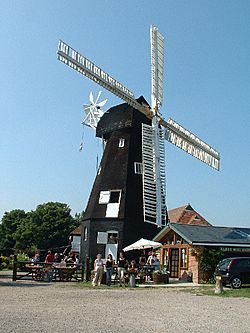Sarre Windmill facts for kids
Quick facts for kids Sarre Windmill |
|
|---|---|
 |
|
| Origin | |
| Grid reference | TR 259 651 |
| Coordinates | 51°20′23″N 1°14′35″E / 51.33972°N 1.24306°E |
| Operator(s) | Hobbs (?–2011) Unknown (2011–) |
| Year built | 1821 |
| Information | |
| Purpose | Corn mill Holiday Let (2011–) |
| Type | Smock mill |
| Storeys | Three-storey smock |
| Base storeys | Two-storey base |
| Smock sides | Eight-sided |
| No. of sails | Four |
| Type of sails | Double Patent sails |
| Windshaft | Cast iron |
| Winding | Fantail |
| Fantail blades | Six bladed |
| Auxiliary power | Steam engine 1861–1920 Gas engine 1920–1940 |
| No. of pairs of millstones | Two pairs |
| Other information | The first windmill in Kent to have a steam engine as auxiliary power. |
Sarre Windmill is a special old building in Sarre, Kent, England. It's a type of windmill called a smock mill, and it was built a long time ago in 1820. This windmill is so important that it's protected as a Grade II listed building. It used to grind corn and was even restored to work again. However, the mill is now closed.
Contents
The Story of Sarre Windmill
How the Mill Was Built
Sarre Windmill was built in 1820 by a person called John Holman. He was a millwright, which is someone who designs and builds mills. Some people thought the mill was moved from a nearby village called Monkton. But it's more likely that some parts or machines from the Monkton mill were used to build Sarre Windmill.
The mill was shown on old maps from the 1800s. When it was first built, it had a short brick base with one floor. In 1856, the base was made taller. An extra floor was added underneath, making the base about 14 feet (4.3 meters) high.
Powering the Mill
Sarre Windmill was the first windmill in Kent to use a steam engine to help it work. This engine was added in 1861. It was used as extra power when the wind wasn't strong enough. The mill continued to use wind power until 1920.
In 1920, the large sails were taken off the mill. They were then moved and put on another famous windmill called the Union Mill in Cranbrook. After the sails were removed, a gas engine was put in place to power Sarre Windmill.
Later Years and Restoration
The mill kept working for a few more years with the gas engine. But by the early 1930s, it stopped grinding corn. It was started up again in the late 1930s, still using the gas engine. However, it finally stopped working in 1940. This happened because the engine was damaged by frost during a very cold winter that year.
During the Second World War, the mill was used as a lookout spot. After the war, it remained in a poor condition for many years. In 1986, work began to restore the mill. This big project was finished in 1991, bringing the mill back to life.
What Sarre Windmill Looks Like
Sarre Windmill is a three-storey smock mill. This means it has a wooden tower that looks a bit like a person wearing a smock (a loose shirt). This tower sits on a two-storey brick base.
The mill has four large sails called double patent sails. These sails are special because they can adjust themselves to the wind. They are held up by a strong cast-iron shaft. The mill also has a fantail. This is a small set of blades at the back that automatically turns the top of the mill to face the wind.
Inside the mill, there are important parts that help it work. The main wheel, called the Brake Wheel, has iron arms and a wooden rim. This wheel turns another gear called a Wallower, which is made of cast iron. The Great Spur Wheel, also made of cast iron, helps to power the grinding stones. Sarre Windmill has two pairs of millstones that grind the corn. These stones are "overdrift," meaning they are driven from above.
Millers of Sarre Windmill
- Thomas Holman (1845 – 1862)
- George Thomas Steddy (1878)
- Ebenezer Wood (1880 – 1883)
- Hogben
- Gambrill (– 1940)
- Malcolm Hobbs (1991 –)
- Robert Hobbs (1991 –)

